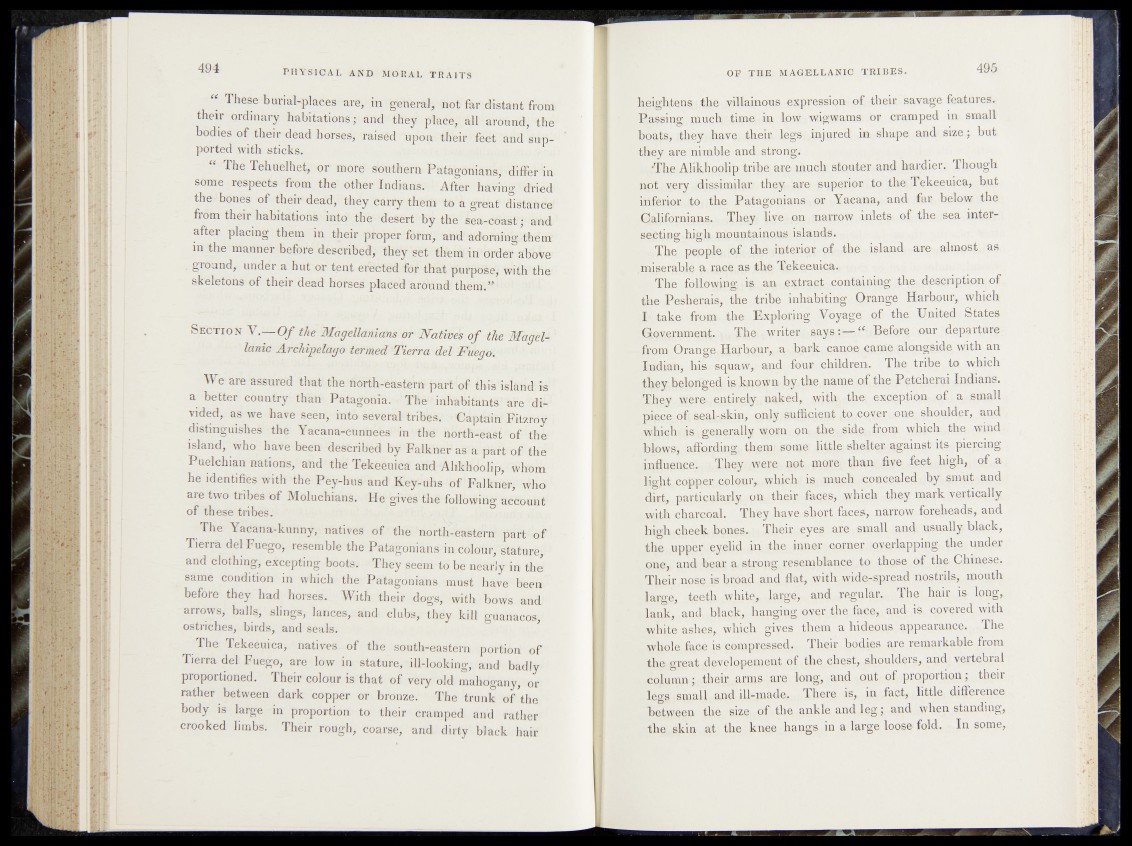
“ These feurial-^lahes are, in geherRl, not distant'from
their ordinary habitations; arid the
bodies of their dead horses, raisid - upon their feet arid Supported
with sticks.
The Tehuelhet, or more Southern Patrigbriians,’ diffiHin
some respects from the^other Indian^; After having dried-
the bones of their dead, they Carry them to a great distance
from their habitations into:the deSert by the'
after placing them in their proper form, and' adorriingithetn'
iie the-manner before described; fhey^SbtbthemrinPrdCr d b f c
ground, under a hut'or tent effected ^Tor that purpdsev With'the'
skeletons of their dead horses placed around* theiri'.*? ' •
S ection V.—-O f the Magellamans or Nafi-&&s of the Mèitfifte
lanic Archipelago termeA^Tiefra ÊèlWiêeg^ -1»
We are assured that the north-eastern part ’of thishsMdia
a better country than Patagonia. J Th^ünfeabitfeMlie M - ;
videdy as we have seen, into Several tribes. -Cdpfiain Fifczüöji'
distinguishes the Yacana-cunriebs^in the ridrtft-e&st-of the-
island, who have been described by Falkner aS* a part of thé'
Puelehian nations, and the Tekeéuica and Ahkgfepy ' ^hofö
he identifies with the Pey-hus and Key-uhs of Falkner, who
are two tribes of Moluchians. He gives thé foMdwiög heèbunt
of these tribes.
The Yacana-kunny, natives of the north-eastern p“art of
Tierra del Fuego; resemble the Patagonians in colour, staturé,.!
and clothing, excepting boots. They seem to be nearly in the
same condition in which the Patagonians must have been
before they had horses. With their dogs, with bows and
arrows, balls, slings, lances, and clubs, they kill guanacos,
ostriches, birds, and seals.
The Tekeeuica, natives, of the south-eastern portion of
Tierra del Fuego, are low in stature, ill-looking, aud badly
proportioned. Their colour is that of very old mahogany, or
rather between dark copper or bronze. The trunk of the
body is large in proportion to their cramped and rather
crooked limbs. Their rough, coarse, and dirty black hair
heighîtens.|itiie ; ^3%iaops-^prefsSion. of. their savage features.
P a c in g . much time.. in low : wigwams, or cramped in small
■tihpy.nfenve their^^jtegsipnjersd. in shape and? size ; hut
they are nimble andistrong.1 -,
^The AJikhpalip tribe; arexnueh s$©!utei?.f&nd hardier. Though
not f yery djssimilan, the^^pre ppp,prior to tbet Tekeeuica, but
mf$?ior,,!t°. .the Puiagppiansrt.er -Yaeana,. and far>, helow the
Californians.-, Thpy. live^/m jnayrow inlets of the sea inter-
septif g .highr^hPrifeinons ! i slands , r
-gThe? peopleüOjÇ|.the anterior of .the riband are .,almost as
The following-is ap extrait containing the.,,description of,
the Pesherais, the tribe inhabiting k Orange Harbour, which
I take from the Exploring, Yoyage pf the; United States
Ciphernmeni. Thb\vwr^eY.'#^$U— oar dèpariure
-from Orangp, fJarhQrir}', a. bark, canoe came alongside with an
Indian, his. squaw, and four children. The tribe to which
theyh^OPgpd pame of thePeteherai Indians.
They.yverp.-entirely naked, with the. pxqeption- of a small
piece pfj seal-skin, only sufliciçnjt (fneQym\,,oq!es shouldgp,, and
which, rjs-^ generally worn on, the, uside> from whichthe wind
b^ys,. .affçgdinggtheiri! mm little shelter against ifo.piercing
influence,,
light, copper colour,. .wh^feis muc^ concealed?,hy smut-.and
dirt, particularly, on their, faces, which they mark vertically
with charcoal. They have short-faces, narrow foreheads, and
high cheek bones. Their eyes arc f small and f usually black,
the upper ,qy.eiid j-a, the,-inner corner overlapping thcj under
one, and bear a strong resemblance .to those of ,thp Qlai^se.
Tlieir nose is broad and flat, with widespread nostrils, mouth
large, teeth white, large, and regular. The hair is long,
lank, and .black, hanging over the.face, and ,is, covered with
white ashes, which gives them a hideous appearance. The
wlrole faqe is compressed. Their bodies are remarkable from
the great .developpment of the chest, shoulders,, and; vertebral
coJ,gmn p their. arrns are long, and .opt of proportion ; their
legs small,arid ill-made. There is, in ;iaet, little difference
between the size of the ankle and leg; and when standing,
the skin at the knee hangs in a large loose fold. In some,
SÜEÎ: